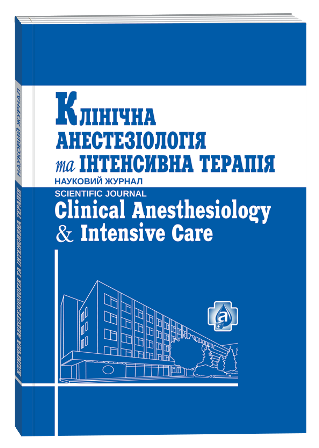ANESTHESIA IN KIDNEY ALLOGRAFTING
Keywords:
kidney, allografting, ischemia, anesthesia, intensive careAbstract
The aim of the study is comparison of two anesthesia techniques and antiischemic protection of graft in 335 patients who underwent cadaveric kidney transplant. Methods. Operative intervention was conducted in 335 patients at final stage of chronic renal failure. Donors were persons aged 18 to 56 years with “brain death” as a result of traumatic brain injury or acute cerebrovascular insufficiency (stroke). The first group (124) patients were used endotracheal anesthesia with artificial lung ventilation at normoventilation mode. Surgery in the second group (211 patients) were performed hemodialysis. The intensive therapy algorithm included nephroprotection elements. Results. Immediate graft function in the second group was observed in 90.3% of recipients. Patients in both groups had increased lipid peroxidation processes, however, the immediate graft function patients had this process only during the first postoperative day. Antioxidant system was more active in patients with immediate function of kidney transplant than those with a postponed one. They were not applied controlled hydration, calcium channel blockers, and mannitol. Conclusions. The central hemodynamics, oxygen transport, lipid peroxidation, antioxidant system were examined. It was proved expediency of intraoperative hemodilution and controlled pharmacological antiischemic protection transplant. Application of sevoflurane anesthesia, increased intraoperative hydration (central venous pressure within 10–12 mm Hg), the use of renoprotection improved results of kidney allografting.
References
Трансплантація нирки від живого родинного донора / Я. Г. Мойсюк, А. В. Шаршаткін, С. М. Арутюнян [та ін.] // Нефрологія та діаліз. – 2003. – № 3. – C. 17–22.
Anesthesia for kidney transplant surgery / J. Sprung, L. Kapural, D. L. Bourke, J. F. O’Hara // Anesthesiol. Clin. Nprth America. – 2000. – Vol. 18 (4). – P. 919–951.
Balanced anesthesia versus total intravenous anesthesia for kidney transplantation / C. Modesti, T. Sacco, G. Morelli [et al.] // Minerva Anestesiol. – 2006. – Vol. 72 (7/8). – P. 627–635.
Haolin M. A. Selection of neuromuscular blocking agents in patients undergoing renal transplantation under general anesthesia / M. A. Haolin // Clin. Med. J. Engl. – 2002. – Vol. 115 (11). – P. 1691–1696.
Kidney NGAL is a novel early marker of acute injury following transplantation / J. Mishra, Q. Ma, C. Kelly [et al.] // Pediatr. Nephrol. – 2006. – Vol. 21 (6). – P. 856–863.
Hypoxanthine as a graft ischemia marker stimulates catalase activity in the renal vein during reperfusion in humans / L. Domanski, K. Safranow, B. Dolegowska [et al.] // Transplant Proc. – 2006. – Vol. 38 (1). – P. 35–38.
Superoxide anion as a marker of ischemia-reperfusion injury of the transplanted kidney / M. Masztalerz, Z. Wlodarczyk, J. Czuczejko [et al.] // Transplant Proc. – 2006. – Vol. 38 (1). – P. 46–48.
Ascorbic acid against reperfusion injury in human renal transplantation / K. Norio, M. Wikstrem, K. Salmela [et al.] // Transpl. Int. – 2003. – Vol. 16 (8). – Р. 480–485.
Lipid peroxidation after cold storage and normothermic reperfusion: the effect of trimetazidine / T. Hauet, H. Baumert, D. Mothes [et al.] // Transpl. Int. – 1998. – Vol. 11, Suppl. 1. – P. 408–409.
Antioxidant supplementation may improve renal transplant function: a preliminary report / C. C. Loong, Y. H. Chang, K. W. King [et al.] // Transplant. Proc. – 2004. – Vol. 36 (8). – P. 2438–2439.
Early phase of reperfusion of human allograft dose not affect an erythrocyte anti-oxidative system / L. Domanski, B. Dolgowska, K. Safranow [et al.] // Nephrology. – 2006. – Vol. 11 (5). – P. 467–470.
Reperfusion injury in renal transplantation: comparison of LD, NHD, NHBD renal transplant / M. A. Gok, B. K. Shenton, M. Relsers [et al.] // Ann Transplant. – 2004. – Vol. 9 (2). – P. 33–34.
Perioperative blood pressure control, delayed graft function, and acute rejection after renal transplantation / M. C. Thomas, T. H. Mathew, G. R. Russ [et al.] // Transplantation. – 2003. – Vol. 12. – P. 1989–1995.
Microcirculation and reperfusion injury in organ transplantation / G. Cicco, P. C. Panzera, G. Catalano, V. Memeo // Adv Exp Med Biol. – 2005. – Vol. 566. – P. 363–373.
Activity of CuZn-superoxide dismutase, catalase and glutatione peroxidase in erythrocyte in kidney allografts dyring reperfusion in patients with and without delayed graft function / L. Domanski, B. Dolegowska, K. Safranow [et al.] // Clin. Transplant. – 2006. – Vol. 1. – P. 67–71.
Early acid-base balance disorders during kidney transplantation / K. Tejchman, L. Domanski, J. Sienko [et al.] // Transplant Proc. – 2006. – Vol. 1. – P. 123–126.







